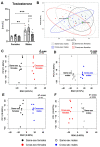The Effect of Cross-Sex Fecal Microbiota Transplantation on Metabolism and Hormonal Status in Adult Rats
- PMID: 38203771
- PMCID: PMC10778742
- DOI: 10.3390/ijms25010601
The Effect of Cross-Sex Fecal Microbiota Transplantation on Metabolism and Hormonal Status in Adult Rats
Abstract
Increasing evidence of sexual dimorphism in the pathophysiology of metabolic complications caused by sex steroids is under investigation. The gut microbiota represents a complex microbial ecosystem involved in energy metabolism, immune response, nutrition acquisition, and the health of host organisms. Gender-specific differences in composition are present between females and males. The purpose of this study was to use cross-sex fecal microbiota transplantation (FMT) for the detection of sex-dependent metabolic, hormonal, and gut microbiota changes in female and male recipients. Healthy non-obese female and male Wistar rats were divided into donor, same-sex, and cross-sex recipient groups. After a 30-day period of FMT administration, biochemical markers (glucose and lipid metabolism) and sex hormones were measured, and the gut microbiota was analyzed. The cross-sex male recipients displayed a significantly lower testosterone concentration compared to the males that received same-sex FMT. Sex-dependent changes caused by cross-sex FMT were detected, while several bacterial taxa correlated with plasma testosterone levels. This study represents the first to study the effect of cross-sex changes in the gut microbiome concerning metabolic and hormonal changes/status in adult non-obese Wistar rats. Herein, we present cross-sex FMT as a potential tool to modify sex-specific pathologies.
Keywords: cross-sex; fecal microbiota transplantation; gut microbiota; metabolic disease; microbiome; sex differences; testosterone.
Conflict of interest statement
The authors declare no conflicts of interest. The funders had no role in the design of the study; in the collection, analyses, or interpretation of the data; in the writing of the manuscript; or in the decision to publish the results.
Figures





Similar articles
-
Gut microbiome-driven regulation of sex hormone homeostasis: a potential neuroendocrine connection.Gut Microbes. 2025 Dec;17(1):2476562. doi: 10.1080/19490976.2025.2476562. Epub 2025 Mar 12. Gut Microbes. 2025. PMID: 40071861 Free PMC article.
-
Fecal Microbiota Transplantation in Experimental Ulcerative Colitis Reveals Associated Gut Microbial and Host Metabolic Reprogramming.Appl Environ Microbiol. 2018 Jul 2;84(14):e00434-18. doi: 10.1128/AEM.00434-18. Print 2018 Jul 15. Appl Environ Microbiol. 2018. PMID: 29728388 Free PMC article.
-
Effects of 'Healthy' Fecal Microbiota Transplantation against the Deterioration of Depression in Fawn-Hooded Rats.mSystems. 2022 Jun 28;7(3):e0021822. doi: 10.1128/msystems.00218-22. Epub 2022 Apr 28. mSystems. 2022. PMID: 35481347 Free PMC article.
-
[Fecal microbiota transplantation].Vnitr Lek. 2016 Feb;62(2):147-51. Vnitr Lek. 2016. PMID: 27172442 Review. Czech.
-
Procedures for Fecal Microbiota Transplantation in Murine Microbiome Studies.Front Cell Infect Microbiol. 2021 Sep 21;11:711055. doi: 10.3389/fcimb.2021.711055. eCollection 2021. Front Cell Infect Microbiol. 2021. PMID: 34621688 Free PMC article. Review.
Cited by
-
Fecal microbiota transplantation: application scenarios, efficacy prediction, and factors impacting donor-recipient interplay.Front Microbiol. 2025 Mar 25;16:1556827. doi: 10.3389/fmicb.2025.1556827. eCollection 2025. Front Microbiol. 2025. PMID: 40201444 Free PMC article. Review.
-
The influence of seminal microbiota on human testicular steroidogenesis: a prospective study.J Assist Reprod Genet. 2025 Mar;42(3):897-907. doi: 10.1007/s10815-024-03351-y. Epub 2025 Jan 7. J Assist Reprod Genet. 2025. PMID: 39776388
-
The role of microbiota and toll-like receptors in polycystic ovary syndrome: regulatory mechanisms of androgen metabolism.Endocr Connect. 2025 Jun 21;14(6):e250162. doi: 10.1530/EC-25-0162. Print 2025 Jun 1. Endocr Connect. 2025. PMID: 40446157 Free PMC article. Review.
-
The Legalome: Microbiology, Omics and Criminal Justice.Microb Biotechnol. 2025 Mar;18(3):e70129. doi: 10.1111/1751-7915.70129. Microb Biotechnol. 2025. PMID: 40072296 Free PMC article.
-
The Androbactome and the Gut Microbiota-Testis Axis: A Narrative Review of Emerging Insights into Male Fertility.Int J Mol Sci. 2025 Jun 27;26(13):6211. doi: 10.3390/ijms26136211. Int J Mol Sci. 2025. PMID: 40649988 Free PMC article. Review.
References
-
- Apovian C.M. Obesity: Definition, comorbidities, causes, and burden. Am. J. Manag. Care. 2016;22:s176–s185. - PubMed
MeSH terms
Substances
Grants and funding
- APVV-21-0370/Slovak Research and Development Agency
- VEGA 1/0649/21/Ministry of Education, Science, Research and Sport of the Slovak Republic
- VEGA 1/0398/24/Ministry of Education, Science, Research and Sport of the Slovak Republic
- CDEIGENT/2021/008/Generalitat Valenciana
- CIACIF/2022/070/Generalitat Valenciana
LinkOut - more resources
Full Text Sources

